Galaxies
Overview
In the 1920s, astronomer Edwin Hubble conclusively showed that our Milky Way galaxy was not the entirety of the universe, but rather just one among many "island universes" that later became known as galaxies.
Galaxies come in many shapes and sizes, from tiny irregulars to massive ellipticals, but in sum and substance, a galaxy is just a collection of star systems, nebulae, gas and dust, and black holes. More recently, it was determined that galaxies also have large amounts of dark matter, but while we can measure the amount of the dark matter component, we still do not know what it is.
Types & Classification Overview
When Hubble discovered that there were other galaxies, it wasn't that he discovered galaxies themselves. Numerous galaxies had been known and identified previously, but they were believed to be nebulae within our own galaxy.
Once he identified them as being outside the galaxy, he developed a classification scheme that is still widely used today: The Hubble Sequence. In this classification scheme, there five main types of galaxies:
- Ellipticals - generally massive galaxies that have no structure other than being ovoid.
- Lenticulars - galaxies with a central bulge surrounded by a disk but that disk is not structured.
- Spirals - a bulge in the center surrounded by spiral arms.
- Barred Spirals - a bar in the center instead of a spherical bulge, generally with only two main arms emanating from the long ends of the bar.
- Irregular - galaxies that have no obvious structure to them.
The Hubble Sequence is shown below:
 |
| The Hubble Sequence of Galaxies, also sometimes called a "Tuning Fork" diagram. Note that irregular galaxies are left off of this version of the diagram. Image courtesy of the HubbleSite. |
Type: Elliptical (E)
Elliptical galaxies are typed E0 through E7, the number indicating how close to a sphere (E0) vs. the most flattened type (E7). Unlike spiral galaxies that are classified in sub-types qualitatively, the sub-type of ellipticals (the number) is defined by the mathematical formula:
![]()
where e is the number (also the ellipticity), b is the shorter axis, and a is the longer axis. e is multiplied by 10 and then set as the sub-type.
Elliptical galaxies usually contain mainly old, yellow or red stars. They generally are not in a very active process of star formation.
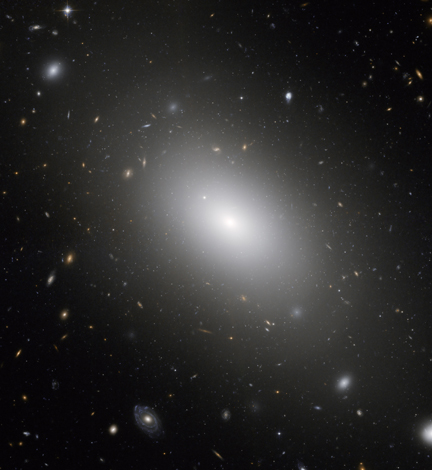 |
| This is NGC 1132, an elliptical galaxy of type E. Image courtesy of the HubbleSite. |
Type: Lenticular (S0)
Lenticular galaxies are between the type of ellipticals and spirals. They are like flattened elliptical galaxies, with a central bulge that is more separated from a surrounding disk of material than ellipticals generally are. In this sense, they are like spiral galaxies, but the disk lacks any of the spiral structure that defines that type. Also, they generally are not in a very active process of star formation.
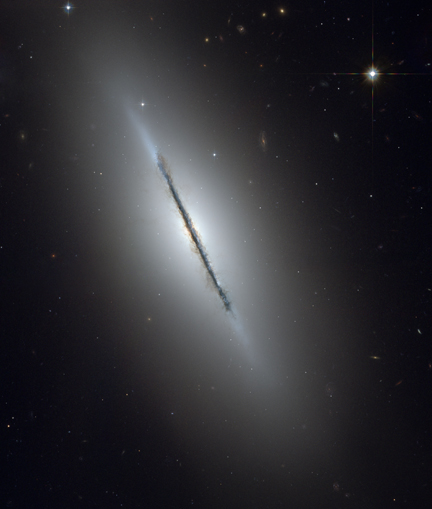 |
| This is NGC 2787, an edge-on (when viewed from Earth) lenticular galaxy of type S0. Image courtesy of the HubbleSite. |
Type: Spiral (S)
Spiral galaxies are usually the most photogenic type, having grand spiral arms that extend from a central bulge or bar. The arms are usually more of a blue color than the bulge, and especially when compared with other galaxy types because they are usually the cites of active star formation, with hot, young, blue stars.
Spirals (S): Spiral galaxies come in three main categories: Sa, Sb, and Sc. The a through c sub-types indicate the tightness and definition of the spiral arms:
- In Sa galaxies, the arms are tightly wrapped and smooth arms with a large central bulge.
- Sb galaxies have less tightly-wound arms, and a fainter bulge.
- Sc galaxies have loosely wound arms, clearly resolved into individual clusters of stars and nebulae. The bulge is still visible, but it is smaller, less prominent, and fainter.
- A fourth type, Sd, was added to the Hubble Sequence by de Vaucouleurs. This type has very loose arms that can be fragmented, and they join together in a central bar but it is not an obvious separate feature.
The sub-types a through c can be combined to indicate more of a transition between two types, such as the example of NGC 1300 below.
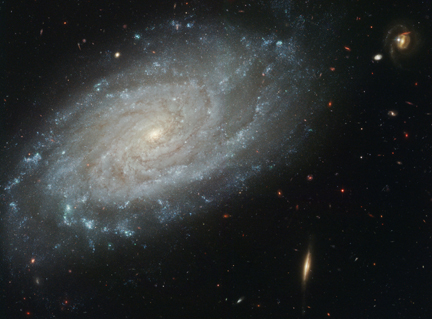 |
| This is NGC 3370, a spiral galaxy of type Sc. Image courtesy of the HubbleSite. |
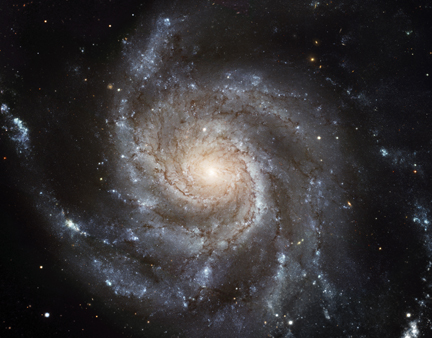 |
| This is M101 (the Pinwheel Galaxy), a spiral galaxy of type Scd. Image courtesy of the HubbleSite. |
Barred Spirals (SB): Barred spiral galaxies come in three main categories, much like regular spiral galaxies: SBa, SBb, and SBc. The a through c sub-types indicate the tightness and definition of the spiral arms:
- In SBa galaxies, the arms are tightly wrapped and smooth arms with a large central bar.
- SBb galaxies have less tightly-wound arms, and a fainter bar.
- SBc galaxies have loosely wound arms, clearly resolved into individual clusters of stars and nebulae. The bar is still visible, but it is smaller, less prominent, and fainter.
- A fourth type, SBd, was added to the Hubble Sequence by de Vaucouleurs. This type has very loose arms that can be fragmented, and they join together in a central bar but it is not an obvious separate feature.
Just as with the S type galaxies, the sub-types a through c can be combined to indicate more of a transition between two types, such as the example of NGC 1300 below.
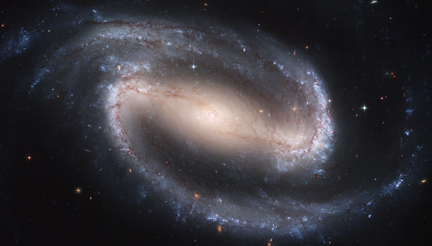 |
| This is NGC 1300, a barred spiral galaxy of type SBbc. Image courtesy of the HubbleSite. |
Type: Irregular (Irr)
The Irregular galaxy type is a catch-all for galaxies that don't fit into the Elliptical, Lenticular, nor Spiral galaxy types. In general, they are oddly shaped with no discernable structure other than - usually - a more dense central region. These galaxies are usually smaller than ellipticals and spirals, and most satellite galaxies (such as those of the Milky Way) are irregular (such as the Large and Small Magellanic Clouds).
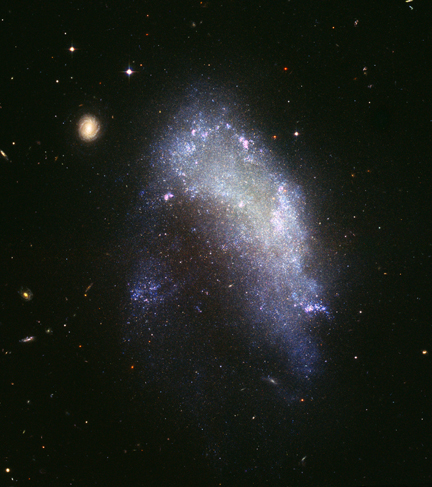 |
| This is NGC 1427A, an irregular galaxy of type Irr. Image courtesy of the HubbleSite. |